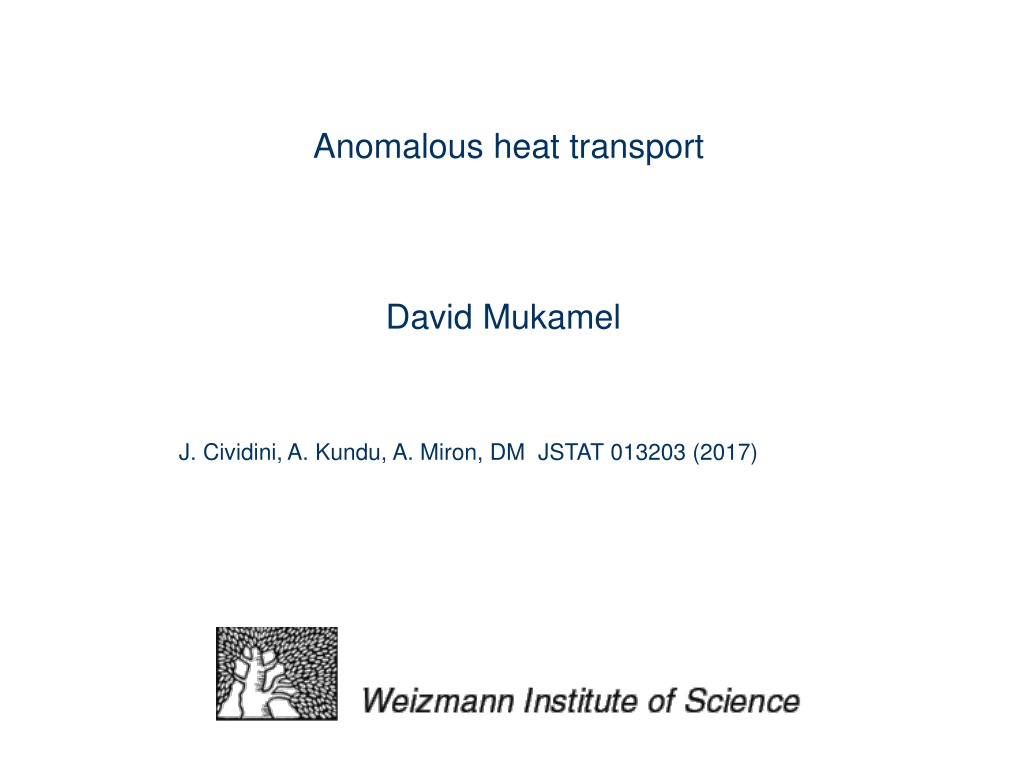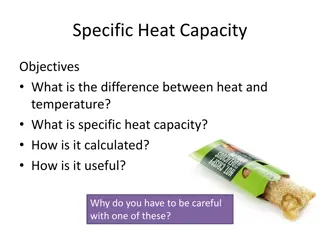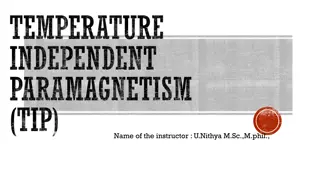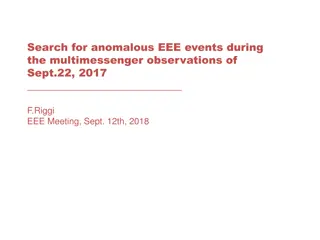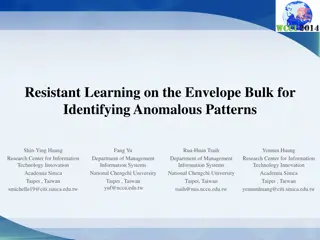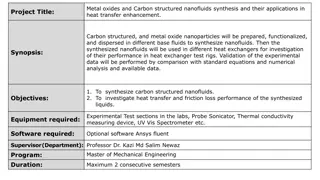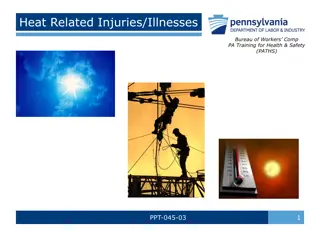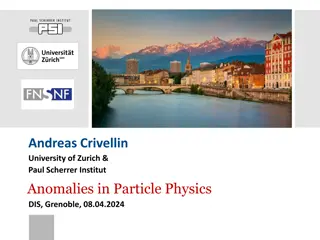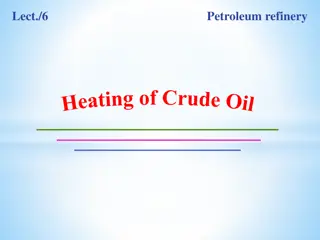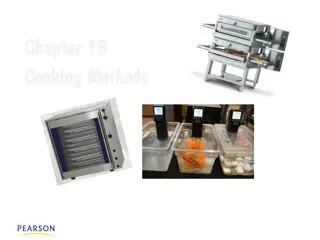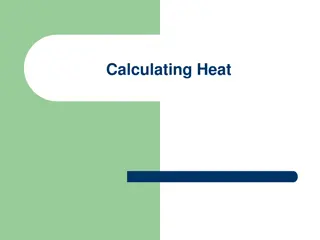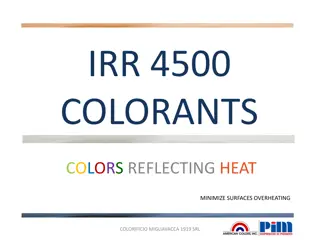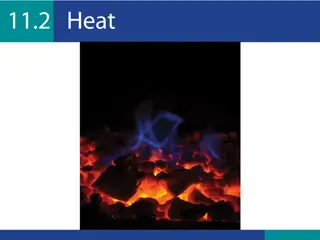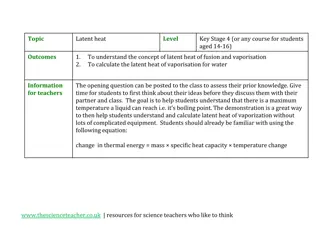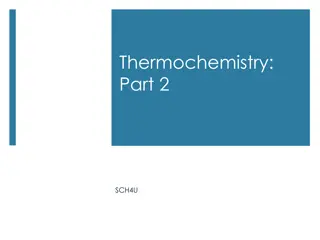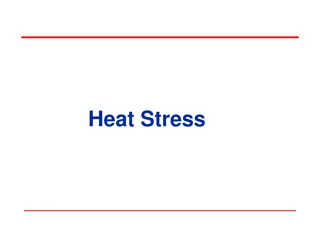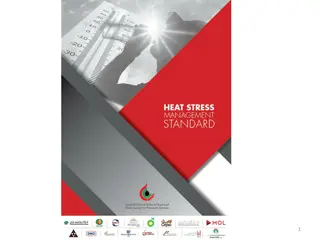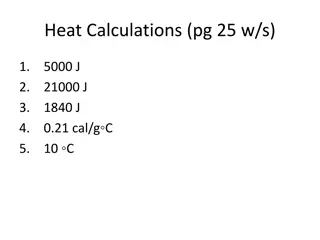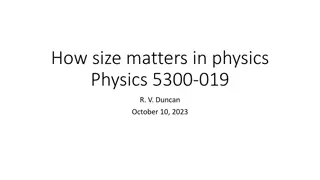Anomalous Heat Transport in Mathematical Physics
Anomalous heat transport deviates from standard Fourier law, exhibiting divergent heat conductance and non-trivial temperature profiles. Observations include long-range time correlations and divergent temperature gradients at boundaries. Models like coupled oscillators and hard disks with alternating masses showcase this phenomenon in diffusive systems.
- Anomalous Heat Transport
- Mathematical Physics
- Fourier Law
- Divergent Heat Conductance
- Coupled Oscillators
Download Presentation

Please find below an Image/Link to download the presentation.
The content on the website is provided AS IS for your information and personal use only. It may not be sold, licensed, or shared on other websites without obtaining consent from the author. Download presentation by click this link. If you encounter any issues during the download, it is possible that the publisher has removed the file from their server.
E N D
Presentation Transcript
Anomalous heat transport David Mukamel J. Cividini, A. Kundu, A. Miron, DM JSTAT 013203 (2017)
Heat transport ? ?+ Fourier law ? = ? ? ? = ?+ ? ? ? is the thermal conductivity In diffusive systems Fourier law is naturally obeyed ?? ??= ?? ? = ??? in steady state ? = 0 and the temperature profile is linear
In many 1d models and in some 2d one observes anomalous heat conduction Main observations: ? ?1 ? 0 < ? 1 ? (? = ? ? ?) divergent heat conductance Long range time correlations Total current ????? = ?(?,?) ? 1 ?????? ????(0)??~ ? (1 ?) 0 ? < 1 Non trivial temperature profile
T 0 N x ?? ?? ? ? (meniscus exponent) ? > 0 Divergent temperature gradient at the boundaries for any ? Anomalous conduction is a result of heat transport models which are faster than diffusion (say ballistic sound modes).
Mathematical Physics (2000) this is what we would consider a satisfactory answer to the challenge in the title of this article and we offer a bottle of very good wine to anyone who provides it.
Typical models: A chain of nonlinear coupled oscillators ? ? 1 ? =1 2+ 2 ?=1 ?? ?(??+1 ??) ?=1 e.g. Fermi-Pasta-Ulam chain ? ? = ?2+ ??3+ ??4 Note: Harmonic chain is a non-generic case in which the modes are non-interacting. As a result ? ? rather then ? ?/?
Hard disks model with alternating masses 1 1 2+ 2 ? = 2?1 ?2? 2?2 ?2?+1 note: when the masses are equal the model does not relax to equilibrium (when ? = 0). Due to energy and momentum conservation particles just exchange momenta in collisions.
Stochastic models Hard disks with three particle collisions ?1+ ?2+ ?3= ?1+ ?2+ ?3 2+ ?2 2+ ?3 2= ?1 2+ ?2 2+ ?3 2 ?1
Two broad classes of approach 1. Non equilibrium setting 2. Equilibrium setting: make use of linear response and apply Green-Kubo formula for the conductivity. ? ? 1 ? = lim ? lim ??2 ?? ?? ?? ? ?,? ? ?,0 ?,?? ? 0 0 1 ? = ??2 ?? ????? ????(0) 0
1 ? = ??2 ?? ????? ????(0) 0 1 ?????? ????(0)??~ ? (1 ?)0 ? < 1 For the integral diverges and the conductivity becomes infinite. To obtain the conductivity of a finite systems one usually introduces a cutoff in time ? ? ?,? is a characteristic sound velocity ? ?? (1 ?)??~?? ?~ ? ? = ?
Calculating the temperature profile apply linear response for the average local current ? ??(?,?)??(?) ? ? = ?? ?? 0 1 ?2 ???,? = ?? ? ?,? ? ?,0 ?,?? 0 In order to carry out this calculation one has to compute the current correlation function for finite system taking into account the coupling to the bath (through the boundary terms).
? For anomalous heat conduction the integral ???,? ?? 0 should diverge with ?. Ignoring boundary terms and taking a large ? scaling limit for large ? ? 1 ???,? ? ? 1 ? ? 1 ?? ???? ? ? ? ? 1 ? 0 1 1 ?? ???? ? =? ? =? ? ? ? ? 1 ? ? ? 0
1 1 ?? ???? ? ? ? ? 1 ? 0 Using Sonin inversion formula the temperature profile is obtained ?? ?? ?(1 ?) ? 2 ? =? ?? ?? ? ? 2 This result does not agree with some explicit model calculation.
outline Introduce a model for which the current correlation function can be computed where the coupling to the heat bath is taken into account. Use it to obtain the temperature profile. Show that the meniscus exponent ? varies continuously with the coupling to the bath.
Harmonic chain with momentum exchange model ? ? 1 2+?2 ? =1 2 2 ?=1 ?? 2 ?=1 ??+1 ?? bulk dynamics: ??? ??= ?? ??? ??= ?2(??+1 2??+ ?? 1) ? = 2, ? 1 In addition: stochastic momentum exchange ?? ??+1with rate ? ?
boundary terms (free bc) and coupling to the bath ??1 ??= ?2?2 ?1 + ?1 ??1 ??? ?? = ?2?? 1 ?? + ?? ??? ?1,??-zero mean Gaussian noise with variances 2??+, 2?? ? N 1
??= ??+1 ?? In terms of the difference variables ??? ??= ??+1 ?? ??? ??= ?2(?? ?? 1) ? = 2, ? 1 ??1 ??= ?2?1+ ?1 ??1 ??? ?? = ?2s? 1+ ?? ??? ?1,??-zero mean Gaussian noise with variances 2??+, 2??
The hydrodynamic limit-bulk equations Three conserved quantities: density, momentum, energy 2 2+ ?? 1 4 2 2+ ?2?? ??=?? ??, ?? , ? N 1 ??? ??= ??+1 ?? ?? ??=?? ?? ??? ??= ?2(?? ?? 1) ?? ??= ?2?? ?? ?? ? ?= 4?2?(??) ??? ??= 2?2??+ ??+1?? ?? 1+ ???? 1 ??
Normal modes ?+?= ??? ?? ?+= ?? ? sound modes ? = ?? + ? ? ?= ???+ ?? ?0 ??=1 2+?2 2+ ??+1 2) energy mode 2?? 4(?? ?0= ? ?? ??=?? ?? ??= ?2?? ?? ? ?= 4?2?(??) ? ??? = ? ??( ?? ) ?? ? ???0= ? ??(? ?? 2 ? 2) ?+ 4 ??
Within the fluctuating hydrodynamic framework- add noise and dissipation ? ??? = ? ??( ?? ?? ??? 2?? ) ? ???0= ? ??[? ? ???0 2 ? 2 ?0 ?+ 2?0?0] 4 ? ? uncorrelated Gaussian white noise The stochastic momentum exchange enters through the ? ?
Instantaneous energy current ? ?,? =? 2?,? ? 2(?,?) ?+ 4 Thus one needs to solve only the equations for the sound modes in order to obtain the energy current
Boundary conditions at ? = 1,? ??? ??= ??+1 ?? ??? ??= ?2(?? ?? 1) ??1 ??= ?2?1 ??1 add variables ?0and ?0such that the equation for ?1becomes regular ??1 ??= ?2?1 ?0 + ?2?0 ??1 ?2?0 ??1= 0 Take time derivative to get an equation for ?0 ?2?1 ?0 ??2?1 ?0 = 0 ?1 ?0 ? ?1 ?0 = 0
Boundary conditions for the sound modes ?1 ?0 ? ?1 ?0 = 0 ?2?0 ??1= 0 for the sound modes in the hydrodynamic limit ?+= ?? ? ? = ?? + ? ? ???++ ?? ?+ ?? ?=0= 0 ??? = 0 ?=0 ? =? ? ? + ?
?+ ? x=0= r or The boundary condition ?+ ?? ?=0= 0 means that if a - Gaussian sound peak hits the left boundary it is reflected and becomes a + sound peak with a reduced amplitude by a factor of r.
when a Gaussian ?+peak hits the right boundary it turns into a ? peak whose integral is multiplied by ? t=200 240 300 ? = 1 ? = 1 ? = 0.25 ? = 500 ? = 0.6 Initial condition: momentum kick to the particles at the center
Comments on the reflection coefficient ? =? ? ? + ? this is the case or resonance, no reflection ? = ? ? = 0 fixed boundary condition ? = ? = 1 ? < 0 means change of phase at reflection
Consider first the case r=0 and solve for the sound modes ? ??? = ? ??( ?? ?? ??? 2?? ) Using the Green s function of the diffusion equation (for ? ) 4???? ? ? ???2 1 4?? ??(?,?,?) = The solution is ??????,?,? ??(?,0)+ 2? 0 ??? 0 ??? ???,?,? ? ????(?,? ) ???,? = 0
For non-vanishing reflection coefficient r The Green s function is + ?2?+(? ?)/2? ? ???+2??? ???2 1 ??,??,?,? = 4?? 4??? ?= And the solution is ? ???,? = ????,??,?,? ??(?,0) 0 ?= ? ? ?? ??,??,?,? ? ????(?,? ) + 2? ?? 0 0 ?=
Calculating the temperature profile ? ?,? =? 2?,? ? 2(?,?) ?+ 4 ? ??(?,?)??(?) ???= ?? ?? 0 1 ?2 ???,? = ?? ? ?,? ? ?,0 ?,?? 0 needs to calculate 2?,? ? 2?,? )(?+ 2?,0 ? 2(?,0) ? ?,? ?(?,0) (?+ this can be done using the solution of ? ?,? and averaging over the initial condition and the noise
?2? ?2? ?2? 1 ?2? 1 1 ?,? = ? ? ? + 2? + ? ?+ 2? ? + ? 2? 2 + ? + ? 2? ? ? ?=1 ? =? ? =? 2 ? ? ? + ? ? = ?2 ? ?
For ? = 0 ? = ? one recovers the kernel of the infinite system 1 ? =1 ?,? = ? ? ? ? 2 The stationary current 1 ???= ? ? 1 ??(?) ?? ? ? ?? ? ? ? 0 Sonin inversion formula ?? ?? ? 1 ? ? 2 meniscus exponent ? =1 4
For ? = 1 (fixed, or fully reflecting bc) the temperature profile has been calculated to yield ? =1 2 S. Lepri, C. Mejia-Monasterio, A. Politi, J. Phys. A 42, 025001 (2009) Thus the meniscus exponent ? depends on the coupling to the heat bath through ?
calculate ?(?) ? ??(?,?)??(?) ???= ?? ?? 0 take derivative with respect to x 1? (?,?) ?? ? =? ? =? ??(?) ?? P.V. ?? = 0 ? ? 0
1?(?,?) ?? ??(?) ?? P.V. ?? = 0 0 ?2? ?2? ?2? 1 ?2? 1 1 ?,? = ? ? ? + 2? + ? ?+ 2? ? + ? 2? 2 + ? + ? 2? ? ? ?=1 Suppose ?? ?? ? ?for small ? The integral yields a ? ? 1 2singularity originating from two terms in (?,?)
?2? ?2? ?2? 1 ?2? 1 1 ?,? = ? ? ? + 2? + ? ?+ 2? ? + ? 2? 2 + ? + ? 2? ? ? ?=1 ? 1 1 ?? ???? + 1 ?? ???? = (? ?)3/2 (? ?)3/2 0 ? ? 1 1 1 (? ?)3/2? ??? + (? ?)3/2? ??? 0 ? ? ? 1/2 1? ? ?? 1 1? ?+ ?? 1/2 1 + ?3/2 2 ?? ? ?? = 0 3 2 0 0 1 ?
R=0 R=1/2 ?+= 1.5 ? = 0.5 ? = ? = 1 ? = 100
One may consider different ?s for the two reservoirs ? ? ?+ The kernel ?(?,?) is the same as before but with reflection coefficients ? = ?+? ? =? ? ? + ?
Levy flight picture of heat transfer S. Lepri, A. Politi PRE, 83 030107 (2011) A. Dhar, K. Saito, B. Derrida PRE 87, 010103 (2013) Levy flight model: Non-interacting particles hop on a 1d line with hopping rate from ? to ? at large |x y| 1 ? ?;? 1 ? 2 |? ?|1+? The model has anomalous current with ? = 2 ? Bath densities: ? ? < 0 = ?+ ? ? > ? = ? ?+ ? What is the density profile for 0 ? ? ?
One finds ? ???;? ? ? ?? ? ? = 0 ? ?;? = ??????(?;?) Thus, for boundaries with reflection coefficient R, Levy flight with the following hopping rate yields the same density profile as the temperature Profile of the heat conduction model with reflection coefficient R. w ?,? ?2? ?2? ?2? 1 ?2? 1 1 = ? ? ?5/2+ (2? + ? ?)5/2+ 2? + ? ?5/2 2? 2 + ? + ?5/2 2? ? ?5/2 ?=1
The meniscus exponent was conjectured to satisfy ? =? 2+ ?(? ? = 2 ? 2 1) For the harmonic chain with momentum exchange ? = 1/2 ? =3 2 1 2? But actually 1? ? ?? 1 1? ?+ ?? 1/2 1 + ?3/2 2 ?? ? ?? = 0 3 2 0 0 1 ?
summary Fluctuating hydrodynamic approach is used to calculate the temperature profile in heat conducting systems. The approach is used for a specific model where the profile and the meniscus exponent are shown to depend on the coupling to the heat bath. Close connection with the Levy flight picture is suggested. Application to other model and how universal are the profiles remain to be explored.
